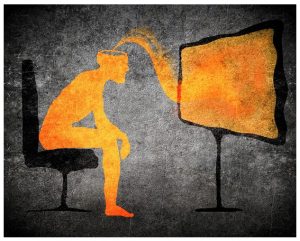Prof. Dr. Hassan Mahmood Mousa Abo Almaali
College of Pharmacy Kerbala University
The treatment of autism spectrum disorder (ASD) has long been a topic of intense research and debate. Among the various approaches that have emerged, the utilization of subliminal stimuli as a potential therapeutic tool has sparked both interest and controversy within the scientific and medical communities. Subliminal stimuli, referring to sensory information presented below the threshold of conscious perception, often bypass the individual’s awareness, have ignited this debate.
Proponents of this approach suggest that subliminal stimuli could play a role in alleviating some symptoms associated with autism. Meanwhile, critics raise concerns about ethics, efficacy, and potential unintended consequences, casting a shadow of doubt over its implementation.

The foundation of subliminal stimuli treatment for autism is rooted in the idea that individuals with ASD may experience heightened sensitivities to sensory input. By delivering subtle and controlled stimuli that evade conscious recognition, proponents hypothesize that it might be possible to modulate neural pathways and influence behavior. These stimuli could take various forms, such as visual images, auditory cues, or even tactile sensations. The theory posits that subliminal exposure to such stimuli could help individuals with autism regulate their sensory experiences, manage emotional responses, and improve social interactions.
Supporters of subliminal stimuli treatment point to research that suggests individuals with autism may process sensory information differently from neurotypical individuals. Some studies have indicated that people with ASD have atypical brain responses to sensory stimuli, indicating potential neural circuitry differences. Proponents argue that subliminal stimuli could potentially tap into these neural pathways, aiding in sensory integration and promoting a more balanced sensory experience. This, in turn, might result in reduced sensory overload and heightened emotional regulation.
However, the concept of subliminal stimuli as a treatment for autism faces considerable skepticism and ethical concerns. One of the main challenges lies in determining the appropriate stimuli, duration, and intensity to use. Tailoring subliminal stimuli for each individual’s unique sensory sensitivities and needs is a complex task, and the potential for unintended negative effects cannot be ignored. Moreover, the lack of a standardized protocol raises questions about the consistency and replicability of any reported positive outcomes.
Ethical considerations also loom large in this discourse. The notion of delivering stimuli that the recipient is unaware of can raise ethical questions about informed consent and manipulation. The vulnerable nature of individuals with autism underscores the need for rigorous ethical guidelines and oversight to ensure that the approach does not infringe upon their rights or exploit their condition. Additionally, the potential for exploitation by unscrupulous practitioners seeking to profit from desperate families must be vigilantly addressed.
Another contentious point of debate centers on the empirical evidence supporting the efficacy of subliminal stimuli treatment for autism. While some studies have suggested positive outcomes, the methodological rigor and sample sizes of these studies are often criticized. The variability of autism itself poses challenges in establishing a standardized baseline against which treatment effects can be measured. The placebo effect, demand characteristics, and experimenter bias are also variables that can influence perceived improvements. Critics contend that the limited, inconclusive evidence available does not justify pursuing this avenue as a primary or sole treatment for autism.
In addition to these challenges, the potential psychological and emotional implications of subliminal stimuli warrant careful consideration. If not administered with extreme caution, subliminal interventions could inadvertently trigger anxiety, distress, or other adverse psychological reactions.
The absence of the individual’s conscious awareness does not eliminate the potential for negative emotional responses, underscoring the need for comprehensive risk assessments and mental health support for individuals undergoing such treatment.
As of last knowledge update, subliminal stimuli treatment for autism remains a highly speculative and controversial area of exploration. While the concept draws upon intriguing theories about sensory processing in autism, the lack of well-established empirical evidence, coupled with ethical concerns, has hindered its widespread acceptance within the scientific and medical communities. It is important to acknowledge that the field of autism research is constantly evolving, and new discoveries may have emerged since then. Therefore, individuals seeking information about potential treatments for autism are encouraged to consult with qualified medical professionals and stay updated with the latest research findings.
References:
⦁ Tanaka M, Yamada E, Yamasaki T, Fujita T, Nakaniwa Y, Ogata K, Nakazono H, Maekawa T, Tobimatsu S. Asynchronous neural oscillations associated with subliminal affective face priming in autism spectrum disorder. Neuroreport. 2023, 1;34 (3):150-155.
⦁ Endevelt-Shapira, Y., Perl, O., Ravia, A. et al.. Altered responses to social chemosignals in autism spectrum disorder. Nat Neurosci 21, 111–119 (2018).
⦁ Svjetlana V, Joseph C, David P., Electrophysiological Correlates of Subliminal Perception of Facial Expressions in Individuals with Autistic Traits: A Backward Masking Study, Front. Hum. Neurosci., 11, 2017.
⦁ Eoffrey B.C. Hall, C. Dianne West, Peter Szatmari, Backward masking: Evidence of reduced subcortical amygdala engagement in autism, Brain and Cognition, Volume 65, Issue 1, 2007, 100-106.
⦁ Cook, J.L., Bird, G. Atypical Social Modulation of Imitation in Autism Spectrum Conditions. J. Autism Dev. Disord., 42 (2012) 1045–1051.
⦁ Heather J., Giacomo V, Kristelle H, Cheryl D, Pupillometry reveals reduced unconscious emotional reactivity in autism, Biological Psychology, 101(2014) 24-35.





























































